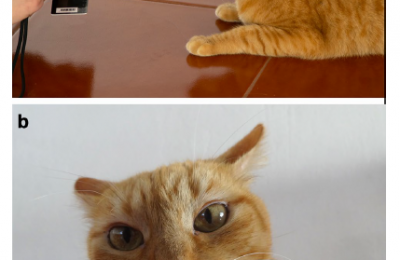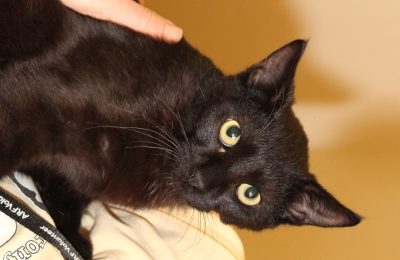Are cats our fur babies? For many of us, we think of our pets as our children, and we love and care for them very deeply. But how do they feel about us? It’s an interesting but challenging question, partly because we can’t ask them directly, but also because in nature, cats don’t have long-term relationships with their parents (and even then, they only have a short-term relationship with their mother!).
Attachment Theory
Attachment theory describes the relationship between a human infant and their caregiver. By testing infants in different situations – including ones where they may feel uncertain – it is determined whether they have a “secure” attachment to their parent. Someone with a secure attachment uses their caregiver as a secure base. This is someone who gives them confidence to explore the world. They also turn to that person for reassurance, seeking comfort from them when scared. Other attachment styles include avoidant, insecure, and disorganized. Attachment styles can impact our later relationships with romantic partners and friends.
The “gold standard” test for human attachment is called the “Strange Situation.” The child is in a novel space with the caregiver. Then the caregiver and a stranger leave and enter the room at different periods. The child’s response to the caregiver’s departure and return, as well as the presence of a stranger help determine the attachment style. Securely attached infants explore when their parent is present. They may get upset when the parent leaves, but are happy to see their parent when they return. They engage with the stranger when alone with them, but prefer to interact with the caregiver.
Dogs and attachment
Multiple studies of dogs suggest that they show similar behaviors as human infants. They are distressed when their human leaves the room, and excited when they return. They prefer to interact with their caregiver over a stranger. However, due to the length of the test (20-30 minutes) some results suggest “fatigue” effects – the dogs explore less later in the test because they are tired, not because of their attachment style.
Variations on the test further suggest that the results are not just because the dog prefers their human. They have a true attachment relationship. Dogs explore and play more (both alone and with the stranger) when their human is present.
Turning to the kitties
It was only a matter of time before researchers turned their attention to the relationship between cats and humans. In 2007, an adapted Strange Situation Test (SST) was used to test 28 cats. There were 7 steps, each three minutes long:
- Cat and owner are left in a novel room, the owner tries to play with the cat
- The stranger enters the room and chats with the owner and tries to play with the cat. At the end of the step, the owner leaves.
- The stranger attempts to interact with the cat
- The owner returns and the stranger leaves
- The cat is left alone
- The stranger returns
- The owner returns
Cats were more active when their owner was present, suggesting exploration and the owner serving as a “secure base.” The cats vocalized more when alone than with a human. The cats also rubbed on their owner more than on the stranger. Are cats showing signs of attachment?
There were flaws in the 2007 study: the analysis included two steps where the human was alone with the cat but only one step with the stranger. The step with the stranger was also the only one where the cat had previously been left alone. This could affect their behavior upon the stranger’s return. The 2007 study also didn’t account for the order of events.
A 2015 study addressed flaws in the previous study, by counter-balancing the order of the events. They also had equal experiences between the owner and the stranger.The results suggested no differences in exploratory behaviors or play when with the stranger or owner. The cats were just as happy to interact with the owner or the stranger.
Dr. Mills explains the research and the findings of the 2015 study in this video:
A 2019 study countered that in fact, cats do show signs of different attachment styles. In an abbreviated “Secure Base Test,” cats spent two minutes in a novel room with their caregiver,. Then they were left alone in the room for two minute. Finally, the caregiver came back for two minutes to complete the test. The cats’ patterns of behavior during the different stages were coded. Most cats (around 60%) were “secure” – they spent time with their caregiver, but also explored. They showed few stress responses and were comforted when their human returned. Other cats were clingy, indifferent, or fearful.
However, because the cats were not also tested with strangers, it is not possible to qualify these interactions with caregivers as “attachment” – in fact, it may be how the cat interacts with any human, not just their caregiver.
A new study questions attachment in cats
A newly published study tested attachment by first positing that their current lifestyle as a successful predator who can reproduce successfully without significant dependence on humans didn’t necessarily set them up for dependence on a specific human.
Cats were tested in a modified Strange Situation Test (SST), which again entailed alternating the presence of the owner and a stranger with a cat in a novel testing room. However, two groups of cats were compared: 13 cats who were pet cats, and 15 cats who were certified therapy cats.
Why compare “typical” pet cats with therapy cats? Because typical pet cats are rarely removed from their home environment. This could affect their behavior during testing in a laboratory environment. Many cats do not show typical behavior when they are away from their familiar territory (for example, when cats are at veterinary clinics, they may not seek out human interaction like they would at home). Therapy cats are socialized and trained for travel, leaving their carrier in a non-familiar space, and interacting with strangers.
The researchers predicted that “pet cats” would show more signs of stress during the SST, and that cats would not show signs of attachment to their owner compared to a stranger. And in fact, there were no differences in the behavior of cats toward their owners or towards a stranger. The therapy cats showed more “attachment behaviors” in general to both the owner and the stranger. They also showed more attachment behaviors overall than the pet cats. The pet cats also showed no differences in behavior toward the owner or the stranger, but they showed more anxiety-type behaviors overall.
The human-cat relationship does not likely meet the criteria for “attachment” as it does for human infants and dogs with their owners. If your cat loves everyone, are they specifically attached to you? Or are they just well-socialized? For those determined to prove that cats are “just as” (insert favorite adjective here) as dogs, this may be a hard result to swallow.
Do these results mean our cats don’t have affection toward us or love us? No. Attachment is not just about having a bond – it’s specifically about the individual utilizing the caregiver as a secure base.
Do these results mean that cats can’t have separation anxiety? No.
But cats do have a very different evolutionary and domestication history than dogs, and just because cats and dogs are the two most popular pets does not mean that their relationships with humans are identical.
It means that cats are cats, and that they evolved with different needs from their humans than dogs did. One big takeaway from this research as far as I’m concerned is the importance of socialization! The socialization that kittens receive is probably the most critical factor in their ability to feel comfortable with ANYONE as adults. The therapy cats in this study probably had three things in common:
- good genes for friendly and bold behavior
- good socialization as kittens
- ongoing training and positive experiences with strangers as adults.
This was a small study, and so I think we should all stay tuned to see how the science of cat-human attachment evolves with more research. It also doesn’t tell us much about how cats interact with humans in the home environment. Again, fodder for more studies!! But we should also take the time to appreciate our cats for who they are, and not try to force them to be just like dogs…because…some of us think cats are even better.
References
Edwards, C., Heiblum, M., Tejeda, A., & Galindo, F. (2007). Experimental evaluation of attachment behaviors in owned cats. Journal of Veterinary Behavior, 2(4), 119-125.
Potter, A., & Mills, D. S. (2015). Domestic cats (Felis silvestris catus) do not show signs of secure attachment to their owners. PLoS One, 10(9), e0135109.
Pongrácz, P., Bensaali-Nemes, F., Bánszky, N., & Dobos, P. (2025). The biological irrelevance of ‘Cattachment’–It’s time to view cats from a different perspective. Applied Animal Behaviour Science, 106641.
Vitale, K. R., Behnke, A. C., & Udell, M. A. (2019). Attachment bonds between domestic cats and humans. Current Biology, 29(18), R864-R865.




Terrific interview with Professor Daniel Mills. I am putting the link on my Facebook page. Celia